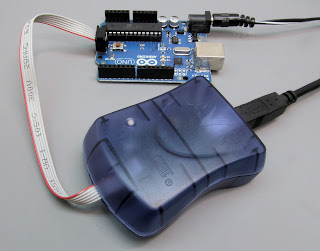 Using Arduino's built-in serial bootloader to upload and run programs is convenient, but a dedicated programming device like the AVRISP mkII can:
Using Arduino's built-in serial bootloader to upload and run programs is convenient, but a dedicated programming device like the AVRISP mkII can:- Program blank (bootloaderless) AVR chips.
- Reduce the time required to upload sketches to the Arduino.
- Save the program memory required by the bootloader.
- Let you program minimal-hardware -inos without a USB/serial adapter.
- Eliminate the issues involved with sharing a UART between the bootloader and a peripheral (such as our serial displays).
This note will offer a few hints and tips for getting started with the AVRISP mkII with Arduino, since this is different from using it with Atmel's development software.

